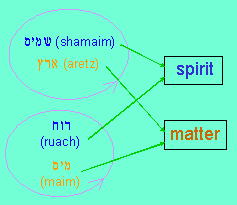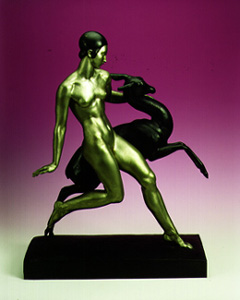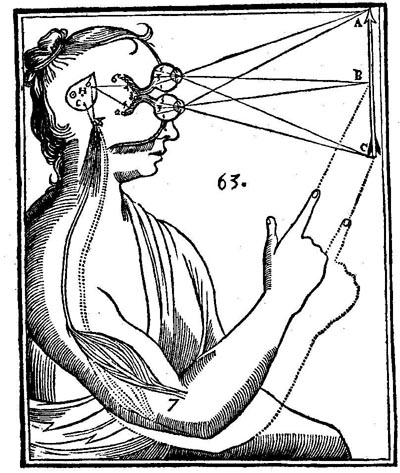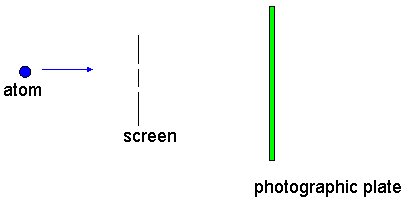She is strikingly described in one of
the so-called "
Homeric
Hymns", from which I quote a few extracts in
Jules Cashford's
free verse translation (2003)
Artemis
I sing
with her golden arrows
and her hunting cry …
In
mountains of shadow
and peaks of wind
she
delights in the chase,
she arches her bow
of solid gold
she
lets fly
arrows
that moan
Crests
of high mountains
tremble,
the forest
in darkness
screams
with
the terrible howling
of wild animals
the earth itself shudders,
… |
when
her heart is
elated,
then she unstrings
her curved bow
and
goes
to the great house
of Phoebus
Apollo,
her dear bother,
in the fertile grasslands
of Delphi
and
there she arranges
the lovely dances
of the Muses and Graces
There
she hangs up
her unstrung bow
and her quiver of arrows,
and
gracefully
clothing her body
she takes first place
at
the dances
and begins |
The picture here abounds in paradox. The contrast between its two
scenes is startling. First we have Artemis the hunter "with her cry",
leaping hither and thither in the darkness of a forest, unleashing
slaughter on the animals, creating such pain, chaos and terror that the
earth herself shudders in anguish. Then "when her heart is elated" we
change scene to Artemis the choreographer, calmly dressed in beautiful
clothes, mingling with the gods in a scene of elegance and beauty. Not
only are heaven and earth extravagantly contrasted, but Artemis is
portrayed as equally at home in each. Reading other accounts (Baring
and
Cashford, 1993, Spretnak) the paradoxes increase: there she is not only
the
huntress of animals, but the carer and protector of animals, and the
goddess of childbirth. How can
all the elements hang together in one image? What is
going on here is the nature
of the mythic realm – it does not adhere to normal logic but to a wider
logic
in which opposites not only coexist, but call each other into
simultaneous
being. The hunter and the hunted are, in all the most ancient European
poetry,
one being. Destruction and creation are inseparable. For reasons that
the logical mind cannot grasp, the
intellectual
realm of heaven is, for Artemis-consciousness, bound up with the
opposite realm
of chaos. They cannot exist without each other. This ancient Goddess
requires all these paradoxes in order to exist.
To relate this to the question of matter we have to turn to the
Greek of the poem. Here two words jump out: hule (forest) and gaia (the earth). While "forest" was the
primary meaning of hule, within
a century at most of this hymn the word was also the normal term for
"matter". It is forest
in the sense of the primordial, the
ground out of which life springs. So the transition of Artemis
between heaven and earth is also a transition between
matter and spirit. And "earth" is being represented through the
feminine aspect of the goddess gaia.
The relationship between spirit and matter, heaven and earth,
expressed in Artemis, injects the dynamic of a circle of creation and
destruction in which gaia "shudders", as if in awe of the birth of
which this speaks. Artemis is
seen as a god of life, while death is of course
present as an essential part of the cycle of life, and chaos as an
essential complement to the elegantly choreographed dances of the muses.
Parallels with the earlier mythology of genesis are still prominent.
The forest/matter of hule seems
akin to the womb-waters of creation (maim)
in genesis; Artemis is classically referred to as "the sounding one"
("with her hunting cry"), reminding us of the root meaning of shamayim in the idea of sound. As
compared with the earlier Hebrew picture, however, it would be fanciful
to try to discern two separate polarities at play here: heaven/spirit
and earth/matter begin to take on a fusion of the two older polarities
Classical Greece
Moving on a little in time, we learn more about the Greek
concept of
matter from Plato. In his work
Timaeus
he describes the creation of
the world from an ideal form of creation conceived in the mind of God.
But
halfway through, a disturbing thought strikes him, a thought that is
one of the great deep
questions of the world. What exactly is it that takes us from the
abstract thought
in the mind of God, to a specific THIS, a real, solid actual existence,
here?
It’s no good saying God can do anything – the whole point of the story
is to
explain the world, and if the
story has no link between the idea and the
reality it explains nothing.
So Plato
posits a counterpoise to intellectual form: a
sort of unthinkable formlessness waiting for form, a “this” that is not
yet a
“this something”, a no-thing-ness that he calls “the receptacle or
nurse of
coming-to-birth”. In the light of Douglas Klotz’s usage, I take
the liberty
of paraphrasing this as “the womb of becoming”. And arising from the
womb
(matter) and the intelligible form is the actual world. Once again, the
identification with maim is clear, while the other categories are
taking on a
different shape, as we move into a different classical world. We can
note that the Latin word that is the source of our "matter" is materia, which is linked with mater, mother - also emphasising
the womb theme.
Another significant role of Plato's "receptacle" is that of providing
space. In the intellectual realm there is no separation, everything,
like our own thoughts, mingles without boundaries. But the created
world is a thing with separation: different things are in different
places, and it is the receptacle, the womb of becoming, that defines a
space in which that is possible. Matter is to do with places.
With Aristotle, matter and spirit are both brought "down to earth" as
the two inseparable aspects to be found in any being: substance and
form. But for him the creative
process is not seen in an interaction
between the two (as suggested by Artemis); instead it is potentiality (dunamis, from which we get
"dynamic") that plays the role of hule/maim.
In the course of
moving from Genesis to Aristotle we have shifted through the emotional
gears. In Genesis all the terms of the polarities were powerful
archetypes, charged with power and mystery. In Aristotle rationality is
dominant, the here-and-now. His mastery of the power of the rational
intellect that had been progressively emerging over the preceding years
is indeed in itself awesome; but it is achieved at the cost of loosing
the lightness, passion and feeling for the sacred that we find in
Plato. Both matter and spirit have lost their divinity. The
"disenchantment of the world" is under way.
The Christian Era and the deprecation of matter
As we move into the Christian phase of the West, the polarisaton of
heaven and earth into different places continues. Originally, when the
enchantment of the world still cast its spell over all peoples, both
heaven and earth carried the numinosity, the otherness, in the heart of
all things. There were represented particularly through those
inaccessible places where this numinosity was most prominent:
shamayim in the peaks of mountains
such as Olympus or Sinai
,
aretz in the rocks of the
wilderness,
maim in the
waters or, in the form of
hule, in
the darkness of the forests. But also the divine was interwoven into
the fabric of everyday life. Now, however, the numinosity, the abode of
the God(s), became restricted to the remote and inaccessible as heaven
and earth became exclusively places and no longer principles. In the
case of Christianity this move was particularly ironic since, as Neil
Douglas-Klotz has shown, the core message of Jesus, who taught using
the language of Aramaic that is close to Hebrew, concerns
malkutah d'bashmaya - the Kingdom
of Heaven (
shmaya) - which is
"among/within you".
Not only did the developing Christian church separate heaven and earth,
but it progressively down-graded the status of earth and with it the
status of matter. A passage from St Paul's letter to the church in
Corinth sets the tone:
(1 Corinthians 15:47)
The first man [i.e. Adam] was of the dust of the earth, the second man
[i.e. Jesus] from heaven. As was the earthly man, so are those who are
of the earth; and as is the man from heaven, so also are those who are of
heaven.
"Dust" (
choikos) is derived
from the word for a rubbish heap - matter has changed from the divine
waters of fecund creativity to the left-over rubbish thrown out from a
perfectly swept heaven.
The 16th and 17th centuries
We now come to the move by Descartes that was to establish the modern
concept of matter, a move that brought the dichotomy between heaven and
earth into the nature of the human being. At the time the teachings of
Aristotle stressing an inseparable polarity of form and matter were
still very influential and, since form could be held to be of divine
origin, acted to mitigate theology's condemnation of matter. Descartes,
however, argued that, when it came to the human being, matter and soul
were two quite separate entities. He defined them by the terms
res extensa (extended stuff) and
res cogitans (thinking stuff)
. Matter
was made up of separate
corpuscles, packed together, whose intrinsic bulk constituted space.
Mind, on the other hand, was independent of space, belonging to a
self-contained realm of pure thought. We see how the connection of
matter with space has been retained from Plato, but now the corpuscular
nature of matter deprives it of any creative potential, and it becomes
Paul's "dust". The only source of true creativity is soul (
res cogitans), which is a
conception of the human mind in its purely rational form, stripped of
the emotions which, according to Descartes (following in the steps of
Augustine) belong to the body, not the soul. Rationality is divine,
feeling is base. Indeed even the soul is incapable, on the earth, of
any true creativity, for all change on the earth consists only of the
rearrangement of the corpuscles of matter which are themselves
unchangeable.
Hule is capable
of transformation, Cartesian matter only of rearrangement.
The picture, from Descartes'
Essai
sur l'homme, illustrates his conception of the human as a
machine presided over by an immaterial soul. One needs to appreciate
that each generation imagines humans in the image its latest
technology, so that just as we imagine the human brain to be a
computer, so Descartes imagined the human body to be a pneumatic
automaton, inspired by the inventive designs in of Salomon de
Caus whose
Les Raisons des Forces
Mouvantes, published in 1615, was studied intensely by
Descartes. He thought that the nerves were pipes that conducted control
fluids to the various muscles, and that the ventricles of the brain
were the reservoirs for these fluids. It was thus natural to see the
pineal gland (the almond-shaped object in the picture), which hangs
down into the the third ventricle, as the control valve of the whole
system, and hence the place where the action of the soul could have
most effect. This mechanisation of the body represents the final loss
of any sacredness of matter.
The introduction by Descartes of corpuscles was part of a general
movement in Europe towards atomism, stemming from a revival of interest
in the second century philosopher Lucretius. Whereas Descartes
corpuscles are packed together so as to constitute space, atoms as
imagined by Lucretius can move freely through the void of empty space;
atomism, in other words, is a philosophical position in which all
things
are made up of certain basic indivisible particles (originally called
atoms, though now we use the word differently)
and an independent pre-existing
void or space. Interestingly, this introduction of space recovers a
shadow of Plato's receptacle, which is strengthened in the work of
Newton who once, in an unguarded moment, likened space to "the
sensorium [sense-organ] of God". In this philosophy it is the
combination of space
and atoms
that stands for the oldest ideas of matter.
Once the Spirit had been completely separated from matter, and matter
had lost its divine quality, the world of the Spirit and God was
destined to become increasingly irrelevant. Religion became personal
piety and Matter began to turn into materialism.
The modern era and beyond
In the twentieth century the first steps were taken towards recovering
the interplay between matter and spirit, and with it a reflection of
the earlier polarities. The period leading to the present day was one
of a reconstruction of the fullness of the world, but along different
lines from those of Genesis. One can trace at least four strands
in this process:
- Within physics, what was at first a desacralised "matter" began
to differentiate to recover a physical representation of all the
previous polarities. First, the dimension of shamayim/aretz emerged in the
discovery of wave-particle duality. Then, in a process that is still in
the course of development and unclear, the ruach/maim polarity started to
emerge as the distinction between principles (usually expressed as
quantum fields) and manifestation (which may be linked with space).
- Within Christian theology, God started to be rehabilitated on the
earth. The movement for social reform which at first had been dominated
by the reformed churches spread into mainstream Protestantism and,
particularly with the birth of liberation theology, Catholicism - where
it was followed by a backlash under pope John-Paul II. Feminist
theology played a significant role here, emphasising the relational
character of God and of God's creation (Grey, 1991). Principles and
practical manifestation (ruach/maim)
came into inter-relationship, as they were doing in physics. What seems
harder is to re-establish an interplay between structure and fluidity.
- "Nature" was progressively reinvented and reenchanted, Aldo
Leopold being a seminal influence (Cronon, 1995). It started to become
once again the domain of Artemis, but now in both of her roles, as the
huntress and the choreographer, no longer separated into two places.
Thinkers such as Berry (1990) and Sahtouris (2000) emphasised the
cyclic interplay of
individuation, competition and destruction (aretz) intertwining cooperation,
communion and creativity (shamayim)
- In the human sciences and spirituality huge strides have been
made in reconnecting what Descartes divided, with a flowering of
body-based spiritualities and mentally based therapies. In a great many
places ruach and maim are again in an interplay, a
process in which the re-empowerment of women has led to an integration
(an embracing of diversity) and co-celebration of the masculine and the
feminine. Noteworthy has been the discovery through experimental
psychology of the way in which this ruach/maim polarity is deeply embedded in
our cognitive processes and shapes the whole of our experienced
world Barnard and Teasdale (1995 ) have established the
existence of two well differentiated meaning-making subsystems of the
mind (probably hard-wired into the brain, though the anatomy of this
has yet to be explored), one dealing with the rational, propositional
and the verbal, and the other dealing with the significance to the
self, the emotions and connectivity with the sensory world.
Based on my own experience I will end by briefly unpacking just the
physics strand of this process, in which what was in the eighteenth
century simply "matter" became unpacked into the fourfold polarity of
Genesis, only one part of which was "matter" in the sense of
hule.
Wave-particle duality
I shall begin with this most well-known aspect, as it is expressed
in the two-slit experiment of Davison and Germer. Atoms are projected
towards a screen with two slits in it onto a photographic plate where
each atom turns a grain of the emulsion black.
The resulting pattern of black dots is seen not to be uniform, or
having two bands, but two be made up of a large number of dark and
light bands, a phenomenon most obviously explained as the result of the
interference of waves
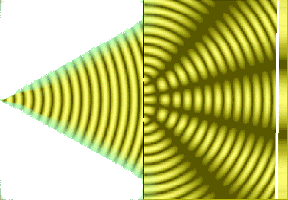
It seems as though all the most
elementary parts of the physical world have two aspects, one of a
particle form, distinct, localised (
aretz),
and the other of a wave form, spreading and connecting (
shamayim). The circumstances
determine which it is that manifests.
Maim and contemporary
quantum theory
Regrettably, physics has got complicated - perhaps an indication of
its coming to the end of its usefulness to human experience. It
currently involves a number of different layers:
- Quantum
fields (pure form, the abstract nature of different particles)
- Quantum
state (real but not actual, potentiality)
- Actual
occurrences (more usually called “observations” - but that word only
really makes sense when people are involved)
- “Be-ables” (specifications of those things that are "able" to
"be" - more usually called “observables”)
– a determining framework within each particular context linking the
quantum state and
actual occurrences
- Curved
space-time (its role both
dynamical and geometrical, still hotly debated)
The point of all this complexity is that "being" is an issue for
contemporary physics, in a way that is not the case in classical
physics. In the latter the world just "is", with no qualifications. Now
there are at least three layers from possible to actual. The
quantum-field is a purely abstract specification of what the
ingredients of physics are: what electrons are, protons and so on, in
the form of hypothetical patterns in space. The quantum state, which is
determined by the quantum field, is a particular specification of the
probabilities for particular outcomes based on the immediate and local
past history. A "be-able" or observable is a specification of the wider
context of a particular situation. Space-time, according to Penrose
(2004), might well be implicated as the arena that initiates the final
step to actual occurrence. The layers from the quantum state to
space-time make a spectrum between
ruach
and
maim, while the
quantum fields are analogous to the archetypal forms that precede any
sort of becoming.
Conclusions
I have charted a progression in which a fourfold polarity,
including matter at one pole, has contracted to the barren
dichotomy of the Cartesian world view and then re-expanded in a
different way. Our challenge today is to allow our own patterns of
thinking and our social institutions to re-expand in the same way. The
world is a living world, whose goddess Artemis moves between birth and
death. Matter in the sense of the barren "stuff" of Descartes was a
temporary aberration in our thought. Rather, every being has a part to
play in the divine interplay of form, receptivity, fixity and
expansion that is the web of life.
References
Anne Baring and Jules Cashford
The
Myth of the Goddess, Arkana, 1993
Philip J Barnard and William D Teasdale
Affect Cognition and Change, Lawrence
Erlbaum Assoicates, 1995
Thomas Berry
The Dream of the Earth,
University of California Press, 1990
Jules
Cashford (Editor), Nicholas
Richardson (Editor)
Homeric
Hymns, Penguin Classics, 2003)
William Cronon
Uncommon Ground, W
W Norton, 1995
Neil Douglas-Klotz,
Desert
Wisdom, Thorsons, 1995
Mary Grey
Redeeming the Dream,
SPCK 1991
Mike King
“Towards a Postsecular Society”, Sea
of Faith Journal, Spring 2003.
Roger Penrose
The Road to Reality, Jonathan
Cape,
2004
Elisabet Sahtouris and James E
Lovelock,
Earthdance, iUniverse,
2000
Charlene Spretnak
States of Grace,
Harper SanFrancistco, 1993
 ). The "root" here,
on his reading,
is "ShM" (
). The "root" here,
on his reading,
is "ShM" ( ) which is also found in words
meaning "hear", "name", "sound" and so on, sharing an underlying idea
of a permeating vibration, or a connecting meaning. A similar analysis
relates the word translated as earth aretz (
) which is also found in words
meaning "hear", "name", "sound" and so on, sharing an underlying idea
of a permeating vibration, or a connecting meaning. A similar analysis
relates the word translated as earth aretz ( )
to a root indicating "a
formed and fixed energy". This distinction clearly has connections with
the "spirit/matter" polarity that we are familiar with; but I shall be
arguing here that the Hebrew polarity has many more intricate overtones
which we can savour. Douglas-Klotz draws a metaphor from modern
physics (which I will consider later) in using the terms "wave" and
"particle" as one interpretation of this polarity.
)
to a root indicating "a
formed and fixed energy". This distinction clearly has connections with
the "spirit/matter" polarity that we are familiar with; but I shall be
arguing here that the Hebrew polarity has many more intricate overtones
which we can savour. Douglas-Klotz draws a metaphor from modern
physics (which I will consider later) in using the terms "wave" and
"particle" as one interpretation of this polarity. ),
like words from other languages more familiar to us, combines the ideas
of breath, wind and spirit - the "breath of life" - but also an idea of
"expansive power". The second,
),
like words from other languages more familiar to us, combines the ideas
of breath, wind and spirit - the "breath of life" - but also an idea of
"expansive power". The second,  ),
has connotations identified by Douglas-Klotz with flow and
generativity, for which he chooses "womb" as one interpretation.
),
has connotations identified by Douglas-Klotz with flow and
generativity, for which he chooses "womb" as one interpretation. 